SCES587D AUGUST 2004 – November 2015 SN74AVCH16T245
PRODUCTION DATA.
- 1 Features
- 2 Applications
- 3 Description
- 4 Revision History
- 5 Description (continued)
- 6 Pin Configuration and Functions
-
7 Specifications
- 7.1 Absolute Maximum Ratings
- 7.2 ESD Ratings
- 7.3 Recommended Operating Conditions
- 7.4 Thermal Information
- 7.5 Electrical Characteristics
- 7.6 Switching Characteristics: VCCA = 1.2 V
- 7.7 Switching Characteristics: VCCA = 1.5 V ± 0.1 V
- 7.8 Switching Characteristics: VCCA = 1.8 V ± 0.15 V
- 7.9 Switching Characteristics: VCCA = 2.5 V ± 0.2 V
- 7.10 Switching Characteristics: VCCA = 3.3 V ± 0.3 V
- 7.11 Operating Characteristics
- 7.12 Typical Characteristics (TA = 25°C)
- 8 Parameter Measurement Information
- 9 Detailed Description
- 10Application and Implementation
- 11Power Supply Recommendations
- 12Layout
- 13Device and Documentation Support
- 14Mechanical, Packaging, and Orderable Information
Package Options
Refer to the PDF data sheet for device specific package drawings
Mechanical Data (Package|Pins)
- DGG|48
- DGV|48
Thermal pad, mechanical data (Package|Pins)
Orderable Information
7 Specifications
7.1 Absolute Maximum Ratings
over operating free-air temperature range (unless otherwise noted(1))| MIN | MAX | UNIT | |||
|---|---|---|---|---|---|
| VCCA
VCCB |
Supply voltage | –0.5 | 4.6 | V | |
| VI | Input voltage(2) | I/O ports (A port) | –0.5 | 4.6 | V |
| I/O ports (B port) | –0.5 | 4.6 | |||
| Control inputs | –0.5 | 4.6 | |||
| VO | Voltage applied to any output in the high-impedance or power-off state(2) | A port | –0.5 | 4.6 | V |
| B port | –0.5 | 4.6 | |||
| VO | Voltage applied to any output in the high or low state(2)(3) | A port | –0.5 | VCCA + 0.5 | V |
| B port | –0.5 | VCCB + 0.5 | |||
| IIK | Input clamp current | VI < 0 | –50 | mA | |
| IOK | Output clamp current | VO < 0 | –50 | mA | |
| IO | Continuous output current | ±50 | mA | ||
| Continuous current through each VCCA, VCCB, and GND | ±100 | mA | |||
| TJ | Junction temperature | –40 | 150 | °C | |
| Tstg | Storage temperature | –65 | 150 | °C | |
(1) Stresses beyond those listed under Absolute Maximum Ratings may cause permanent damage to the device. These are stress ratings only, which do not imply functional operation of the device at these or any other conditions beyond those indicated under Recommended Operating Conditions. Exposure to absolute-maximum-rated conditions for extended periods may affect device reliability.
(2) The input voltage (VI ) and output negative-voltage (VO ) ratings may be exceeded if the input and output current ratings are observed.
(3) The output positive-voltage rating may be exceeded up to 4.6 V maximum if the output current rating is observed.
7.2 ESD Ratings
| VALUE | UNIT | |||
|---|---|---|---|---|
| V(ESD) | Electrostatic discharge | Human-body model (HBM), per ANSI/ESDA/JEDEC JS-001(1) | ±8000 | V |
| Charged-device model (CDM), per JEDEC specification JESD22-C101(2) | ±1000 | |||
| Machine model (A115-A) | ±200 | |||
(1) JEDEC document JEP155 states that 500-V HBM allows safe manufacturing with a standard ESD control process. Manufacturing with less than 500-V HBM is possible with the necessary precautions.
(2) JEDEC document JEP157 states that 250-V CDM allows safe manufacturing with a standard ESD control process. Manufacturing with less than 250-V CDM is possible with the necessary precautions.
7.3 Recommended Operating Conditions
over operating free-air temperature range (unless otherwise noted)(1) (2) (3)| VCCI | VCCO | MIN | MAX | UNIT | |||
|---|---|---|---|---|---|---|---|
| VCCA | Supply voltage | 1.2 | 3.6 | V | |||
| VCCB | Supply voltage | 1.2 | 3.6 | V | |||
| VIH | High-level input voltage |
Data inputs(4) | 1.2 V to 1.95 V | VCCI × 0.65 | V | ||
| 1.95 V to 2.7 V | 1.6 | ||||||
| 2.7 V to 3.6 V | 2 | ||||||
| VIL | Low-level input voltage |
Data inputs(4) | 1.2 V to 1.95 V | VCCI × 0.35 | V | ||
| 1.95 V to 2.7 V | 0.7 | ||||||
| 2.7 V to 3.6 V | 0.8 | ||||||
| VIH | High-level input voltage |
DIR (referenced to VCCA)(5) |
1.2 V to 1.95 V | VCCA × 0.65 | V | ||
| 1.95 V to 2.7 V | 1.6 | ||||||
| 2.7 V to 3.6 V | 2 | ||||||
| VIL | Low-level input voltage |
DIR (referenced to VCCA)(5) |
1.2 V to 1.95 V | VCCA × 0.35 | V | ||
| 1.95 V to 2.7 V | 0.7 | ||||||
| 2.7 V to 3.6 V | 0.8 | ||||||
| VI | Input voltage | 0 | 3.6 | V | |||
| VO | Output voltage | Active state | 0 | VCCO | V | ||
| Tri-State | 0 | 3.6 | |||||
| IOH | High-level output current | 1.2 V | –3 | mA | |||
| 1.4 V to 1.6 V | –6 | ||||||
| 1.65 V to 1.95 V | –8 | ||||||
| 2.3 V to 2.7 V | –9 | ||||||
| 3 V to 3.6 V | –12 | ||||||
| IOL | Low-level output current | 1.2 V | 3 | mA | |||
| 1.4 V to 1.6 V | 6 | ||||||
| 1.65 V to 1.95 V | 8 | ||||||
| 2.3 V to 2.7 V | 9 | ||||||
| 3 V to 3.6 V | 12 | ||||||
| Δt/Δv | Input transition rise or fall rate | 5 | ns/V | ||||
| TA | Operating free-air temperature | –40 | 85 | °C | |||
(1) VCCI is the VCC associated with the input port.
(2) VCCO is the VCC associated with the output port.
(3) All unused data inputs of the device must be held at VCCI or GND to ensure proper device operation. Refer to the TI application report, Implications of Slow or Floating CMOS Inputs, SCBA004.
(4) For VCCI values not specified in the data sheet, VIH min = VCCI × 0.7 V, VIL max = VCCI × 0.3 V.
(5) For VCCA values not specified in the data sheet, VIH min = VCCA × 0.7 V, VIL max = VCCA × 0.3 V.
7.4 Thermal Information
| THERMAL METRIC(1) | SN74AVCH16T245 | UNIT | |||
|---|---|---|---|---|---|
| TSSOP (DGG) |
TVSOP (DGV) |
ZQL/GQL (BGA MICROSTAR JUNIOR) |
|||
| 48 PINS | 48 PINS | 56 PINS | |||
| RθJA | Junction-to-ambient thermal resistance | 82.5 | 69.9 | 64.6 | °C/W |
| RθJC(top) | Junction-to-case (top) thermal resistance | 34.2 | 23.9 | 16.6 | °C/W |
| RθJB | Junction-to-board thermal resistance | 45.1 | 36.6 | 30.8 | °C/W |
| ψJT | Junction-to-top characterization parameter | 2.7 | 1.7 | 0.9 | °C/W |
| ψJB | Junction-to-board characterization parameter | 44.6 | 36.2 | 64.6 | °C/W |
(1) For more information about traditional and new thermal metrics, see the Semiconductor and IC Package Thermal Metrics application report, SPRA953.
7.5 Electrical Characteristics
over recommended operating free-air temperature range (unless otherwise noted)(1)(2)| PARAMETER | TEST CONDITIONS | VCCA | VCCB | TA = 25°C | TA = –40°C to 85°C | UNIT | |||||
|---|---|---|---|---|---|---|---|---|---|---|---|
| MIN | TYP | MAX | MIN | MAX | |||||||
| VOH | IOH = –100 μA | VI = VIH | 1.2 V to 3.6 V | 1.2 V to 3.6 V | VCCO – 0.2 | V | |||||
| IOH = –3 mA | 1.2 V | 1.2 V | 0.95 | ||||||||
| IOH = –6 mA | 1.4 V | 1.4 V | 1.05 | ||||||||
| IOH = –8 mA | 1.65 V | 1.65 V | 1.2 | ||||||||
| IOH = –9 mA | 2.3 V | 2.3 V | 1.75 | ||||||||
| IOH = –12 mA | 3 V | 3 V | 2.3 | ||||||||
| VOL | IOL = 100 μA | VI = VIL | 1.2 V to 3.6 V | 1.2 V to 3.6 V | 0.2 | V | |||||
| IOL = 3 mA | 1.2 V | 1.2 V | 0.15 | ||||||||
| IOL = 6 mA | 1.4 V | 1.4 V | 0.35 | ||||||||
| IOL = 8 mA | 1.65 V | 1.65 V | 0.45 | ||||||||
| IOL = 9 mA | 2.3 V | 2.3 V | 0.55 | ||||||||
| IOL = 12 mA | 3 V | 3 V | 0.7 | ||||||||
| II | Control inputs |
VI = VCCA or GND | 1.2 V to 3.6 V | 1.2 V to 3.6 V | ±0.025 | ±0.25 | ±1 | μA | |||
| IBHL(3) | VI = 0.42 V | 1.2 V | 1.2 V | 25 | μA | ||||||
| VI = 0.49 V | 1.4 V | 1.4 V | 15 | ||||||||
| VI = 0.58 V | 1.65 V | 1.65 V | 25 | ||||||||
| VI = 0.7 V | 2.3 V | 2.3 V | 45 | ||||||||
| VI = 0.8 V | 3.3 V | 3.3 V | 100 | ||||||||
| IBHH(4) | VI = 0.78 V | 1.2 V | 1.2 V | –25 | μA | ||||||
| VI = 0.91 V | 1.4 V | 1.4 V | –15 | ||||||||
| VI = 1.07 V | 1.65 V | 1.65 V | –25 | ||||||||
| VI = 1.6 V | 2.3 V | 2.3 V | –45 | ||||||||
| VI = 2 V | 3.3 V | 3.3 V | –100 | ||||||||
| IBHLO(5) | VI = 0 to VCC | 1.2 V | 1.2 V | 50 | μA | ||||||
| 1.6 V | 1.6 V | 125 | |||||||||
| 1.95 V | 1.95 V | 200 | |||||||||
| 2.7 V | 2.7 V | 300 | |||||||||
| 3.6 V | 3.6 V | 500 | |||||||||
| IBHHO(6) | VI = 0 to VCC | 1.2 V | 1.2 V | –50 | μA | ||||||
| 1.6 V | 1.6 V | –125 | |||||||||
| 1.95 V | 1.95 V | –200 | |||||||||
| 2.7 V | 2.7 V | –300 | |||||||||
| 3.6 V | 3.6 V | –500 | |||||||||
| Ioff | A port | VI or VO = 0 to 3.6 V | 0 V | 0 to 3.6 V | ±0.1 | ±2.5 | ±5 | μA | |||
| B port | 0 to 3.6 V | 0 V | ±0.1 | ±2.5 | ±5 | ||||||
| IOZ(7) | A or B port | VO = VCCO or GND, VI = VCCI or GND |
OE = VIH | 3.6 V | 3.6 V | ±0.5 | ±2.5 | ±5 | μA | ||
| B port | OE = don't care | 0 V | 3.6 V | ±5 | |||||||
| A port | 3.6 V | 0 V | ±5 | ||||||||
| ICCA | VI = VCCI or GND, IO = 0 | 1.2 V to 3.6 V | 1.2 V to 3.6 V | 25 | μA | ||||||
| 0 V | 3.6 V | –5 | |||||||||
| 3.6 V | 0 V | 25 | |||||||||
| ICCB | VI = VCCI or GND, IO = 0 | 1.2 V to 3.6 V | 1.2 V to 3.6 V | 25 | μA | ||||||
| 0 V | 3.6 V | 25 | |||||||||
| 3.6 V | 0 V | –5 | |||||||||
| ICCA + ICCB | VI = VCCI or GND, IO = 0 | 1.2 V to 3.6 V | 1.2 V to 3.6 V | 45 | μA | ||||||
| Ci | Control inputs |
VI = 3.3 V or GND | 3.3 V | 3.3 V | 3.5 | pF | |||||
| Cio | A or B port | VO = 3.3 V or GND | 3.3 V | 3.3 V | 7 | pF | |||||
(1) VCCI is the VCC associated with the input port.
(2) VCCO is the VCC associated with the output port.
(3) The bus-hold circuit can sink at least the minimum low sustaining current at VIL max. IBHL should be measured after lowering VIN to GND and then raising it to VIL max.
(4) The bus-hold circuit can source at least the minimum high sustaining current at VIH min. IBHH should be measured after raising VIN to VCC and then lowering it to VIH min.
(5) An external driver must source at least IBHLO to switch this node from low to high.
(6) An external driver must sink at least IBHHO to switch this node from high to low.
(7) For I/O ports, the parameter IOZ includes the input leakage current.
7.6 Switching Characteristics: VCCA = 1.2 V
over recommended operating free-air temperature range, VCCA = 1.2 V (see Figure 11)| PARAMETER | FROM (INPUT) |
TO (OUTPUT) |
VCCB = 1.2 V | VCCB = 1.5 V | VCCB = 1.8 V | VCCB = 2.5 V | VCCB = 3.3 V | UNIT |
|---|---|---|---|---|---|---|---|---|
| TYP | TYP | TYP | TYP | TYP | ||||
| tPLH | A | B | 4.1 | 3.3 | 3 | 2.8 | 3.2 | ns |
| tPHL | 4.1 | 3.3 | 3 | 2.8 | 3.2 | |||
| tPLH | B | A | 4.4 | 4 | 3.8 | 3.6 | 3.5 | ns |
| tPHL | 4.4 | 4 | 3.8 | 3.6 | 3.5 | |||
| tPZH | OE | A | 6.4 | 6.4 | 6.4 | 6.4 | 6.4 | ns |
| tPZL | 6.4 | 6.4 | 6.4 | 6.4 | 6.4 | |||
| tPZH | OE | B | 6 | 4.6 | 4 | 3.4 | 3.2 | ns |
| tPZL | 6 | 4.6 | 4 | 3.4 | 3.2 | |||
| tPHZ | OE | A | 6.6 | 6.6 | 6.6 | 6.6 | 6.8 | ns |
| tPLZ | 6.6 | 6.6 | 6.6 | 6.6 | 6.8 | |||
| tPHZ | OE | B | 6 | 4.9 | 4.9 | 4.2 | 5.3 | ns |
| tPLZ | 6 | 4.9 | 4.9 | 4.2 | 5.3 |
7.7 Switching Characteristics: VCCA = 1.5 V ± 0.1 V
over recommended operating free-air temperature range, VCCA = 1.5 V ± 0.1 V (see Figure 11)| PARAMETER | FROM (INPUT) |
TO (OUTPUT) |
VCCB = 1.2 V | VCCB = 1.5 V ± 0.1 V | VCCB = 1.8 V ± 0.15 V | VCCB = 2.5 V ± 0.2 V | VCCB = 3.3 V ± 0.3 V | UNIT | ||||
|---|---|---|---|---|---|---|---|---|---|---|---|---|
| TYP | MIN | MAX | MIN | MAX | MIN | MAX | MIN | MAX | ||||
| tPLH | A | B | 3.6 | 0.5 | 6.2 | 0.5 | 5.2 | 0.5 | 4.1 | 0.5 | 3.7 | ns |
| tPHL | 3.6 | 0.5 | 6.2 | 0.5 | 5.2 | 0.5 | 4.1 | 0.5 | 3.7 | |||
| tPLH | B | A | 3.3 | 0.5 | 6.2 | 0.5 | 5.9 | 0.5 | 5.6 | 0.5 | 5.5 | ns |
| tPHL | 3.3 | 0.5 | 6.2 | 0.5 | 5.9 | 0.5 | 5.6 | 0.5 | 5.5 | |||
| tPZH | OE | A | 4.3 | 1 | 10.1 | 1 | 10.1 | 1 | 10.1 | 1 | 10.1 | ns |
| tPZL | 4.3 | 1 | 10.1 | 1 | 10.1 | 1 | 10.1 | 1 | 10.1 | |||
| tPZH | OE | B | 5.6 | 1 | 10.1 | 0.5 | 8.1 | 0.5 | 5.9 | 0.5 | 5.2 | ns |
| tPZL | 5.6 | 1 | 10.1 | 0.5 | 8.1 | 0.5 | 5.9 | 0.5 | 5.2 | |||
| tPHZ | OE | A | 4.5 | 1.5 | 9.1 | 1.5 | 9.1 | 1.5 | 9.1 | 1.5 | 9.1 | ns |
| tPLZ | 4.5 | 1.5 | 9.1 | 1.5 | 9.1 | 1.5 | 9.1 | 1.5 | 9.1 | |||
| tPHZ | OE | B | 5.5 | 1.5 | 8.7 | 1.5 | 7.5 | 1 | 6.5 | 1 | 6.3 | ns |
| tPLZ | 5.5 | 1.5 | 8.7 | 1.5 | 7.5 | 1 | 6.5 | 1 | 6.3 | |||
7.8 Switching Characteristics: VCCA = 1.8 V ± 0.15 V
over recommended operating free-air temperature range, VCCA = 1.8 V ± 0.15 V (see Figure 11)| PARAMETER | FROM (INPUT) |
TO (OUTPUT) |
VCCB = 1.2 V | VCCB = 1.5 V ± 0.1 V | VCCB = 1.8 V ± 0.15 V | VCCB = 2.5 V ± 0.2 V | VCCB = 3.3 V ± 0.3 V | UNIT | ||||
|---|---|---|---|---|---|---|---|---|---|---|---|---|
| TYP | MIN | MAX | MIN | MAX | MIN | MAX | MIN | MAX | ||||
| tPLH | A | B | 3.4 | 0.5 | 5.9 | 0.5 | 4.8 | 0.5 | 3.7 | 0.5 | 3.3 | ns |
| tPHL | 3.4 | 0.5 | 5.9 | 0.5 | 4.8 | 0.5 | 3.7 | 0.5 | 3.3 | |||
| tPLH | B | A | 3 | 0.5 | 5.2 | 0.5 | 4.8 | 0.5 | 4.5 | 0.5 | 4.4 | ns |
| tPHL | 3 | 0.5 | 5.2 | 0.5 | 4.8 | 0.5 | 4.5 | 0.5 | 4.4 | |||
| tPZH | OE | A | 3.4 | 1 | 7.8 | 1 | 7.8 | 1 | 7.8 | 1 | 7.8 | ns |
| tPZL | 3.4 | 1 | 7.8 | 1 | 7.8 | 1 | 7.8 | 1 | 7.8 | |||
| tPZH | OE | B | 5.4 | 1 | 9.2 | 0.5 | 7.4 | 0.5 | 5.3 | 0.5 | 4.5 | ns |
| tPZL | 5.4 | 1 | 9.2 | 0.5 | 7.4 | 0.5 | 5.3 | 0.5 | 4.5 | |||
| tPHZ | OE | A | 4.2 | 1.5 | 7.7 | 1.5 | 7.7 | 1.5 | 7.7 | 1.5 | 7.7 | ns |
| tPLZ | 4.2 | 1.5 | 7.7 | 1.5 | 7.7 | 1.5 | 7.7 | 1.5 | 7.7 | |||
| tPHZ | OE | B | 5.2 | 1.5 | 8.4 | 1.5 | 7.1 | 1 | 5.9 | 1 | 5.7 | ns |
| tPLZ | 5.2 | 1.5 | 8.4 | 1.5 | 7.1 | 1 | 5.9 | 1 | 5.7 | |||
7.9 Switching Characteristics: VCCA = 2.5 V ± 0.2 V
over recommended operating free-air temperature range, VCCA = 2.5 V ± 0.2 V (see Figure 11)| PARAMETER | FROM (INPUT) |
TO (OUTPUT) |
VCCB = 1.2 V | VCCB = 1.5 V ± 0.1 V | VCCB = 1.8 V ± 0.15 V | VCCB = 2.5 V ± 0.2 V | VCCB = 3.3 V ± 0.3 V | UNIT | ||||
|---|---|---|---|---|---|---|---|---|---|---|---|---|
| TYP | MIN | MAX | MIN | MAX | MIN | MAX | MIN | MAX | ||||
| tPLH | A | B | 3.2 | 0.5 | 5.6 | 0.5 | 4.5 | 0.5 | 3.3 | 0.5 | 2.8 | ns |
| tPHL | 3.2 | 0.5 | 5.6 | 0.5 | 4.5 | 0.5 | 3.3 | 0.5 | 2.8 | |||
| tPLH | B | A | 2.6 | 0.5 | 4.1 | 0.5 | 3.7 | 0.5 | 3.3 | 0.5 | 3.2 | ns |
| tPHL | 2.6 | 0.5 | 4.1 | 0.5 | 3.7 | 0.5 | 3.3 | 0.5 | 3.2 | |||
| tPZH | OE | A | 2.5 | 0.5 | 5.3 | 0.5 | 5.3 | 0.5 | 5.3 | 0.5 | 5.3 | ns |
| tPZL | 2.5 | 0.5 | 5.3 | 0.5 | 5.3 | 0.5 | 5.3 | 0.5 | 5.3 | |||
| tPZH | OE | B | 5.2 | 0.5 | 9.4 | 0.5 | 7.3 | 0.5 | 5.1 | 0.5 | 4.5 | ns |
| tPZL | 5.2 | 0.5 | 9.4 | 0.5 | 7.3 | 0.5 | 5.1 | 0.5 | 4.5 | |||
| tPHZ | OE | A | 3 | 1 | 6.1 | 1 | 6.1 | 1 | 6.1 | 1 | 6.1 | ns |
| tPLZ | 3 | 1 | 6.1 | 1 | 6.1 | 1 | 6.1 | 1 | 6.1 | |||
| tPHZ | OE | B | 5 | 1 | 7.9 | 1 | 6.6 | 1 | 6.1 | 1 | 5.2 | ns |
| tPLZ | 5 | 1 | 7.9 | 1 | 6.6 | 1 | 6.1 | 1 | 5.2 | |||
7.10 Switching Characteristics: VCCA = 3.3 V ± 0.3 V
over recommended operating free-air temperature range, VCCA = 3.3 V ± 0.3 V (see Figure 11)| PARAMETER | FROM (INPUT) |
TO (OUTPUT) |
VCCB = 1.2 V | VCCB = 1.5 V ± 0.1 V | VCCB = 1.8 V ± 0.15 V | VCCB = 2.5 V ± 0.2 V | VCCB = 3.3 V ± 0.3 V | UNIT | ||||
|---|---|---|---|---|---|---|---|---|---|---|---|---|
| TYP | MIN | MAX | MIN | MAX | MIN | MAX | MIN | MAX | ||||
| tPLH | A | B | 3.2 | 0.5 | 5.5 | 0.5 | 4.4 | 0.5 | 3.2 | 0.5 | 2.7 | ns |
| tPHL | 3.2 | 0.5 | 5.5 | 0.5 | 4.4 | 0.5 | 3.2 | 0.5 | 2.7 | |||
| tPLH | B | A | 2.8 | 0.5 | 3.7 | 0.5 | 3.3 | 0.5 | 2.8 | 0.5 | 2.7 | ns |
| tPHL | 2.8 | 0.5 | 3.7 | 0.5 | 3.3 | 0.5 | 2.8 | 0.5 | 2.7 | |||
| tPZH | OE | A | 2.2 | 0.5 | 4.3 | 0.5 | 4.2 | 0.5 | 4.1 | 0.5 | 4 | ns |
| tPZL | 2.2 | 0.5 | 4.3 | 0.5 | 4.2 | 0.5 | 4.1 | 0.5 | 4 | |||
| tPZH | OE | B | 5.1 | 0.5 | 9.3 | 0.5 | 7.2 | 0.5 | 4.9 | 0.5 | 4 | ns |
| tPZL | 5.1 | 0.5 | 9.3 | 0.5 | 7.2 | 0.5 | 4.9 | 0.5 | 4 | |||
| tPHZ | OE | A | 3.4 | 0.5 | 5 | 0.5 | 5 | 0.5 | 5 | 0.5 | 5 | ns |
| tPLZ | 3.4 | 0.5 | 5 | 0.5 | 5 | 0.5 | 5 | 0.5 | 5 | |||
| tPHZ | OE | B | 4.9 | 1 | 7.7 | 1 | 6.5 | 1 | 5.2 | 0.5 | 5 | ns |
| tPLZ | 4.9 | 1 | 7.7 | 1 | 6.5 | 1 | 5.2 | 0.5 | 5 | |||
7.11 Operating Characteristics
TA = 25°C| PARAMETER | TEST CONDITIONS |
VCCA = VCCB = 1.2 V | VCCA = VCCB = 1.5 V | VCCA = VCCB = 1.8 V | VCCA = VCCB = 2.5 V | VCCA = VCCB = 3.3 V | UNIT | ||
|---|---|---|---|---|---|---|---|---|---|
| TYP | TYP | TYP | TYP | TYP | |||||
| CpdA(1) | A to B | Outputs enabled |
CL = 0, f = 10 MHz, tr = tf = 1 ns |
1 | 1 | 1 | 1 | 2 | pF |
| Outputs disabled |
1 | 1 | 1 | 1 | 1 | ||||
| B to A | Outputs enabled |
13 | 13 | 14 | 15 | 16 | |||
| Outputs disabled |
1 | 1 | 1 | 1 | 1 | ||||
| CpdB(1) | A to B | Outputs enabled |
CL = 0, f = 10 MHz, tr = tf = 1 ns |
13 | 13 | 14 | 15 | 16 | pF |
| Outputs disabled |
1 | 1 | 1 | 1 | 1 | ||||
| B to A | Outputs enabled |
1 | 1 | 1 | 1 | 2 | |||
| Outputs disabled |
1 | 1 | 1 | 1 | 1 | ||||
(1) Power dissipation capacitance per transceiver. Refer to the TI application report, CMOS Power Consumption and Cpd Calculation, SCAA035
7.12 Typical Characteristics (TA = 25°C)
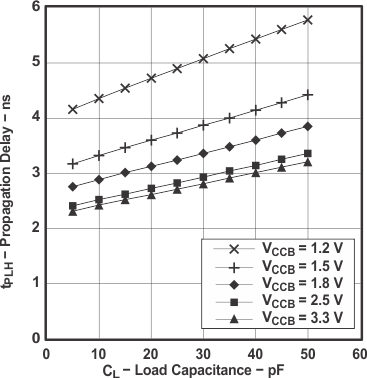
| VCCA = 1.2 V |
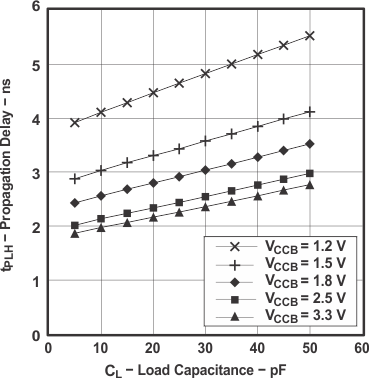
| VCCA = 1.5 V |
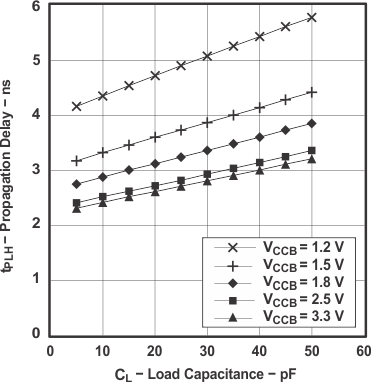
| VCCA = 1.8 V |
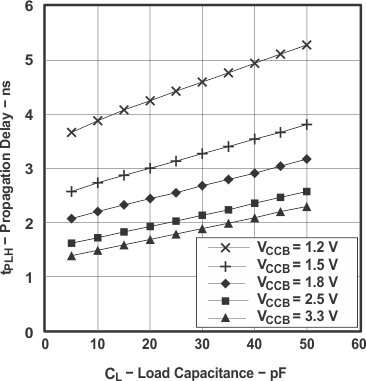
| VCCA = 2.5 V |
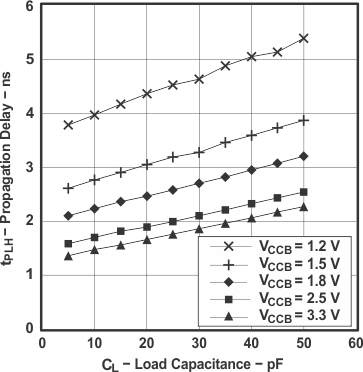
| VCCA = 3.3 V |
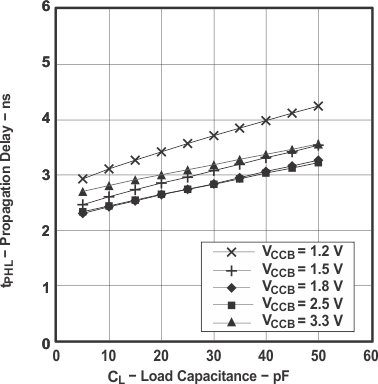
| VCCA = 1.2 V |
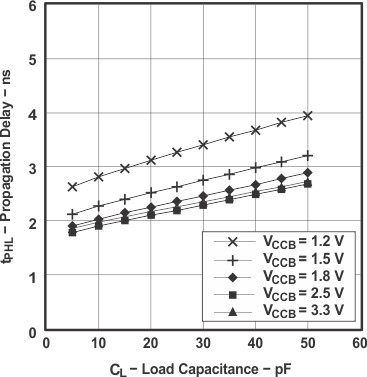
| VCCA = 1.5 V |
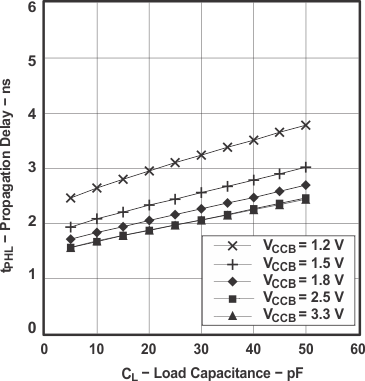
| VCCA = 1.8 V |
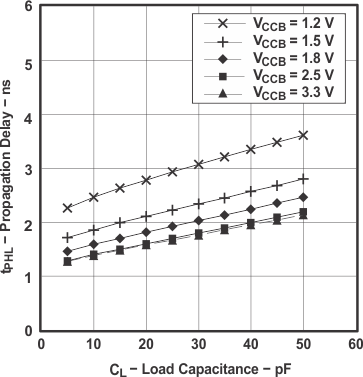
| VCCA = 2.5 V |
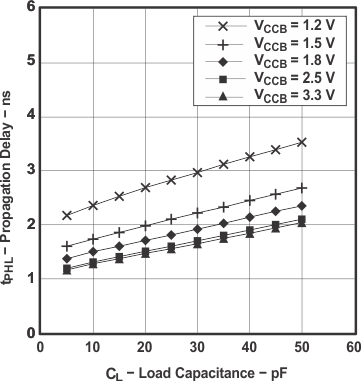
| VCCA = 3.3 V |